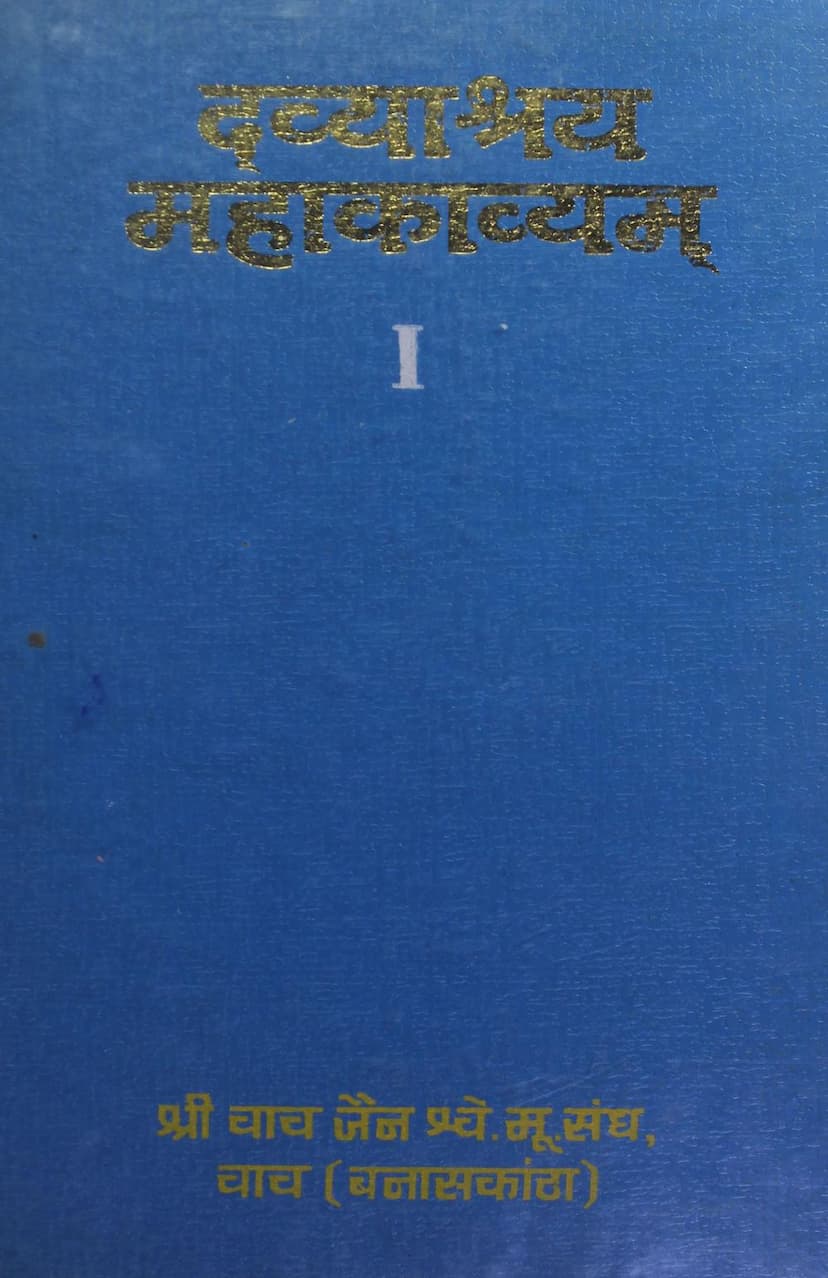Dwayashray Mahakavya Part 01
Added to library: September 1, 2025

Summary
The following is a comprehensive summary of the provided Jain text, Dvyāśray Mahākāvya Part 01, authored by Hemchandracharya and with a commentary by Abhaytilak Gani, published by Wav Jain S M P Sangh.
Overall Context:
- Title: Dvyāśray Mahākāvya Part 01 (द्वयाश्रय महाकाव्यम् भाग ०१)
- Author: Acharya Hemchandrasuri (कलिकालसर्वज्ञ आचार्यभगवत् श्री हेमचन्द्रसूरि)
- Commentary By: Shri Abhaytilak Gani (श्री अभयतिलकगणिविरचितया टीकया समेतम्)
- Published By: Shri Wav Jain Shwetambar Moortipujak Sangh, Wav (Banaskantha) (श्री वाव जैन श्वेताम्बर मूर्तिपूजक सङ्घ, वाव (बनासकांठा))
- Content Covered: Cantos 1 to 10 (सर्गाः १-१०)
- Inspiration: Muni Shri Arvindvijay (प्रेरणा : पूज्यपाद विद्वद्वर्य मुनिवरः श्री अरविन्दविजयः)
- Blessing: Pujyapad Acharyadev Shrimad Vijay Omkarsurishwarji Maharaj (आशीर्वचनम् : पूज्यपादाचार्यदेव श्रीमद् विजयॐकारसूरीश्वराः)
- Purpose: The Dvyāśray Mahākāvya is a unique literary creation designed to serve a dual purpose:
- Grammatical Illustration: It serves as a comprehensive illustration of Acharya Hemchandrasuri's own groundbreaking grammar, the Siddhahaima Śabdānuśāsana (सिद्धिहेम शब्दानुशासन). The name "Dvyāśraya" (द्वयाश्रय) itself signifies "resting on two bases," referring to grammar and history.
- Historical Narrative: It recounts the history of the Caulukya dynasty of Gujarat (चौलुक्यवंश), from King Mūlarāja (मृळाज) to King Kumārapāla (कुमरपाल).
Key Highlights and Themes:
-
Author and His Genius: Acharya Hemchandrasuri is lauded as "Kalikālasarvajña" (कलिकालसर्वज्ञ), meaning "omniscient of the Kali Age." His contributions spanned various fields including grammar, lexicography, poetics, philosophy, and history, demonstrating unparalleled erudition and depth.
-
Historical Scope: The Dvyāśray Mahākāvya is a significant historical document, meticulously weaving the annals of the Caulukya rulers. It details their reigns, administrations, policies, battles, and significant events. The text mentions kings like Mūlarāja, Chāmundarāja, Durlabharāja, Nāgarāja, Bhīma, Karṇa, and Jayasiṁha, culminating with the reign of Kumārapāla.
-
Grammar and Poetry Fusion: The genius of Hemchandracharya lies in seamlessly blending profound grammatical rules with captivating poetry. Each verse or canto is crafted to exemplify specific grammatical principles, making the study of grammar both informative and aesthetically pleasing. The commentary by Abhaytilak Gani further elucidates these intricate connections.
-
Illustrative Examples: The poem draws extensively from the Siddhahaima Śabdānuśāsana. It illustrates numerous grammatical rules, including root collections, prefixes, suffixes, compound words, gender distinctions, and rare usages, showcasing Hemachandra's mastery over linguistic intricacies.
-
Historical Authenticity and Artistic License: While the Dvyāśrayakāvya is an important historical source, the introduction by Dr. Satyal Pal Narang notes that Hemachandra sometimes adapted historical facts and sequences to fit the characteristics of a mahākāvya (epic poem). This includes exaggerative style, introduction of mythological elements, and character modifications to serve his illustrative purpose.
-
Social Reforms and Patronage: The text indirectly highlights Hemachandra's influence on social reforms during the reign of Kumārapāla. It mentions abolitions of animal slaughter, wine selling, and confiscation of property, along with liberal grants for occupational shifts. The patronage of Siddharāja and Kumārapāla towards Hemachandra is also evident.
-
Literary Merit: Beyond grammar and history, Dvyāśrayakāvya is appreciated for its poetic qualities. Hemachandra's diction is described as "pepper in taste" (Marica-pāka), indicating its complexity and richness. The poem employs various figures of speech and twenty-nine different metres, showcasing his command over metrics and poetic expression.
-
Re-publication Efforts: The introduction notes that the Dvyāśrayakāvya had been out of print for a long time. The publication by Shri Wav Jain Shwetambar Moortipujak Sangh, with the inspiration of Muni Shri Arvindvijayji, is presented as a commendable effort to revive access to this valuable text.
Summary of Cantos (1-10):
- Canto 1 (Pages 1-125): Focuses on the glorious lineage of the Caulukya dynasty, introducing King Mūlarāja. It describes the city of Aṇahilpur (अणहिलपुर) and Mūlarāja's wisdom and virtues. The canto also includes auspicious beginnings and prayers.
- Canto 2 (Pages 126-208): Continues with Mūlarāja's reign, detailing his administration, policies, an invasion over Somanātha, and its defense. It portrays his succession planning and eventual renunciation of the world.
- Canto 3 (Pages 209-297): Chronicles the reigns of Mūlarāja's successors, including Chāmundarāja and Durlabharāja. It covers events such as royal expeditions, battles, and the characteristic svayamvara (bride selection).
- Canto 4 (Pages 298-362): Details the reigns of Nāgarāja and Bhīmarāja, highlighting their administrative skills, military campaigns against confederated kings, and the emergence of Prince Karṇa. It also includes aspects of mahākāvya literature like descriptions of seasons, love affairs, and divine interventions.
- Canto 5 (Pages 363-442): Focuses on the reign of King Jayasiṁha (Siddharāja), who is presented as a significant patron of Hemachandra. It describes his military exploits, administrative reforms, construction of the Rudramahālaya (रुद्रमहालय) and a Mahāvīra temple, and his travels.
- Canto 6 (Pages 443-514): Covers the early life and ascension of King Kumārapāla, his conflicts with enemies like Anna and Ballāla, and his eventual victory. It elaborates on the conventional descriptions found in mahākāvyas, including descriptions of nature, women, and royal festivities.
- Canto 7 (Pages 515-582): Details Kumārapāla's reign, his significant social reforms like the abolition of animal slaughter and wine selling, and his patronage of Jainism and Hemachandra. It concludes with his administration and religious deeds.
- Canto 8 (Pages 583-664): Continues with the reign of Kumārapāla, covering his administrative achievements, religious activities, and interactions with other rulers and scholars. The narrative of Hemachandra's interaction with Kumārapāla, including his role in Kumārapāla's accession and subsequent guidance, is a central theme.
- Canto 9 (Pages 665-752): Continues the narrative, further illustrating grammatical rules through historical events and actions of the kings.
- Canto 10 (Pages 753-815): Continues the detailed historical and grammatical exposition.
In essence, Dvyāśray Mahākāvya Part 01 is a monumental work that not only preserves the history of a significant Indian dynasty but also serves as an indispensable resource for understanding the intricacies of Jain grammar and the literary prowess of Acharya Hemchandrasuri.